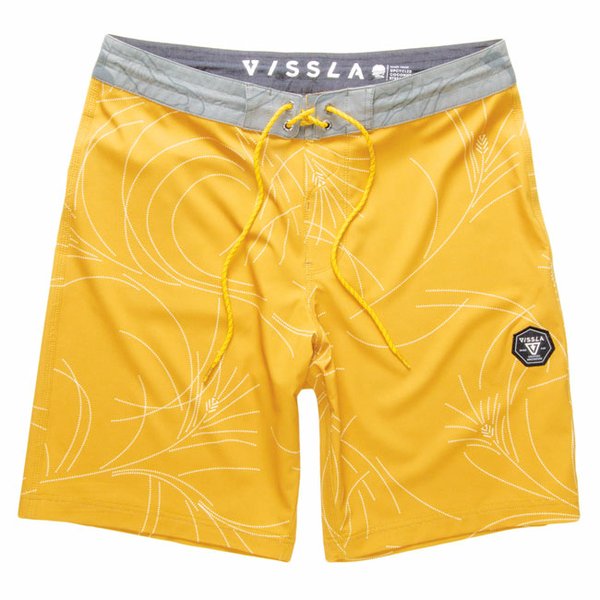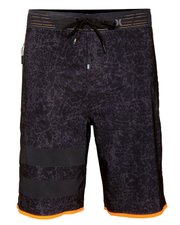BEACH LIFESTYLE
Building a Better Boardshort
Modern surfing was born in Hawaii, took root in California and spread across the world. Since its early days, surfers have been on a quest to find the right gear to wear while surfing. The first attempts were catastrophes. Some of the pioneering surfers would wear cutoff shorts, which would fill up with water and balloon out when the surfer tried to stand up. Or they would fall off, causing some embarrassment and potentially destroying a good ride. Or they would get waterlogged and take hours to dry. After hours of surfing and beachcombing, the shorts would turn into a health hazard. They would chafe the surfer’s skin and cause some awful rashes, said Todd Roberts, co-founder of the ZJ Boarding House surf shop in Santa Monica, Calif. Even for a hardy group of people, there was a call for comfortable, durable gear to brave the waves and live the beach lifestyle.
Bragging rights for the first professionally made boardshorts have been taken by Katin Surf Shop in Huntington Beach, Calif. Katin label lore says that a surfer asked Nancy Katin, a sailboat-cover maker, to make swimwear out of sailboat-cover canvas in the mid-1950s. The swimwear experiment was meant to create a garment that would tough out the elements. Word spread, and more surfers asked for the canvas shorts meant to be worn on a surfboard. A new garment category was born, said Glenn Hughes, who owns Katin Surf Shop.
“They had no idea what would come of it or what it would be. They knew it was making money for them,” Hughes said of boardshorts. In 1961, Katin and her husband hired Sato Hughes, Glenn’s Japanese-born mother, specifically to sew the boardshorts for them. When Nancy died in 1986, Sato took over Katin Surf Shop. At age 86, she still works seven-hour days, five days a week, sewing Katin boardshorts.
The first boardshorts featured four panels of sturdy fabric, a fly area and a cinched waistband. Since then, they have always been more than swimwear, said Rob McCarty, designer for the Vissla brand, who grew up surfing in South Carolina. “It’s a piece of equipment,” he said. “You need it for surfing. It has been a uniform since [surfing’s] counter-culture days of the ’50s and ’60s. It defines your personality.”
Boardshorts’ distinctive look can be compared with other sports uniforms, said Vans designer Gulliver Farnan.
“A boardshort is a 3-D graphic poster, really,” he said. “The best boardshorts are impactful. You have to be recognizable to the brand.”
You also have to be recognizable in the water. Just like a jockey will wear unique silks in a horse race, a surfer wants unique boardshorts to stand out.
“You have got to tell who is riding what horse,” Farnan said.
McCarty and Farnan are part of an elite group of designers with the understanding and know-how to elevate a pair of trunks into essential gear. It’s a lot of responsibility and information to pack into a few ounces of fabric. But these designers are also surfers who have a close understanding of what works and what doesn’t when facing the onslaught of monster waves.
“It’s not just designing product,” ZJ Boarding House’s Roberts said. “Surfers are designing for themselves.”
At core surf shops, some of the most significant parts of retail real estate are devoted to boardshorts. At ZJ Boarding House, boardshorts comprise one-third of the shop’s apparel revenue.
“It is why we dedicate boardshort walls,” Roberts said of the massive boardshort displays in the three shops in the ZJ Boarding House compound. There’s multi-brand ZJ Boarding House and separate boutiques for the Billabong and Hurley brands, all of which Roberts and Mikke Pierson own and operate. “In the Hurley building we have two boardshort walls,” he said.
Surfing performance
Before the Great Recession, jeans, T-shirts and a lot of fashion became baroque. Boardshorts were no exception. Many of them bore elaborate appliqués and stitching, which made a great fashion statement, but in the water the appliqués would fall off or make the suit unnecessarily heavy or get tangled up in heavy surf.
The complaint made its way to the designers of the Hurley label, said Ryan Hurley, the creative director of the Costa Mesa, Calif.–based brand, owned by Nike.
“One of the things we’ve been focusing on is insight from our athletes,” Hurley said. “It started with Rob Machado.” Machado is one of the sport’s top stars, with more than 12 titles from the Association of Surfing Professionals to his name.
“If I can be lighter, faster and more flexible, that would be a big help,” Hurley recalled Machado saying. “That put us on the path to Phantom innovation.”
The Phantom was able to make such a splash because of its performance focus, Hurley said.
It uses less fabric than other boardshorts. It has a slimmer fit. The Phantom also has no stitching between seams, which can chafe the skin, Roberts said. “Instead of stitching the seam, they weld it,” he said.
A key point of difference for the Phantom is perhaps a sense of minimalism. “It’s about what’s not in it,” Hurley said. “We probably have a reductive approach to design. It’s stripping things away. It’s getting to a second skin.”
The Phantom features four-way stretch fabric and a waistband designed to mimic movement of the waist, which offers better flexibility in the waves. There is special coating on the boardshort’s material, which is waterproof and minimizes water absorption once in the water. It’s made from recycled fabric made from 12 plastic bottles per pair.
Since the Phantom was introduced, the performance-oriented boardshort was honored with the “best boardshort” award six years in a row by a group of Hurley’s peers, the Surf Industry Manufacturers Association.
But when Hurley introduced it more than seven years ago, it was a little too different. “Everybody thought we were nuts,” Hurley said. “It was double the price point of what was out there. It was so much more flexible, it was disruptive. Looking back, the market needed the disruption.”
Roberts remembered being bullish on the Phantom, but there was still no guarantee that it was going to perform well.
“It was technically in your face. It was very expensive. We liked the technical aspect. We liked how it was marketed,” Roberts said.
Individual Phantoms came packed in boxes and with DVDs. “We were sticker-shocked,” Roberts said. “It was over $100. To our surprise, we sold dozens of them. We had some people buying two and three pairs.”
Shoes to Shorts
Vans started in the 1960s as the originators of the skateboarding shoe. The Cypress, Calif.–based brand, now owned by VF Corp., has been making surfwear for a long time. It hired Australian-born Farnan in 2013 as its boardshort designer. It’s Farnan’s job to blend performance, Vans heritage and fashion to make a boardshort that will help with a good ride, be true to Vans style and look good.
For Spring ’15, Vans introduced a new fabric called Vans Sturdy Stretch. “It’s the perfect balance between durability and performance stretch without being too light and clingy,” Farnan said. But the official slogan for the Sturdy Stretch is humorous. It “keeps the cling off of your thing,” marketing material says, which is good perspective, according to Farnan. “We don’t take ourselves too seriously,” Farnan said. “After all, it’s a boardshort, not a space suit.”
Farnan works with the Vans surf team to come up with unique looks. Nathan Fletcher, a Vans team rider, wanted to note his Native American heritage on his boardshorts.
For Joel Tudor, another Vans team rider, the style for his boardshorts mixes elements of surfing history with Tudor’s interest in military looks. “We mixed a ’60s-looking indigo daisy print with a vintage-looking, pigment-printed, army-green solid to make it look like an old canvas rucksack carried by a soldier,” Farnan said.
Heritage Meets Innovation
The Vissla brand is headquartered in the south Orange County town of Aliso Viejo. When surf veteran Paul Naude started it in late 2013, he wanted to give surfers a new, modern take on surfing and boardshorts that he felt the other brands were not offering. Naude gained surf-industry prominence when he served as the president of the American division of Billabong International Ltd. His Stokehouse Unlimited company started business shortly after he left Billabong in 2013. Stokehouse also is the parent company of Vissla, Amuse Society and D’Blancc, an eyewear brand.
For its boardshort program, Naude and McCarty, Vissla’s vice president of design, included performance fabric for the sake of comfort and to support efforts to catch a great wave. But they also wanted to reflect the surf culture in the boardshorts and take the design a few steps further.
Many Vissla prints are inspired by African and Hawaiian graphics. Some have retro-like graphics of lifeguard stations and outrigger canoes in the Vissla’s “Hellbent for Hawaii” boardshorts.
Vissla also introduced a new fabric, which is inspired by many surfers’ passion for the environment. It’s called Cocotex. The fabric is made out of coconut husks and offers the elasticity of any other boardshort, according to a Vissla statement, but it’s constructed out of a natural fiber. Cocotex also repels water and dries faster. The fabric is said to breathe easier than others, so it fights odors and is durable. Cocotex is blended with Repreve recycled polyester yarns.
“We try to keep them simple, clean and also make them function well,” McCarty said. “They are tech, but they don’t look tech.”

























